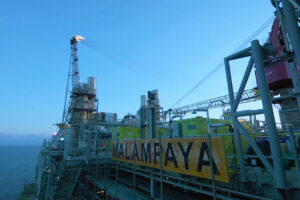LNG a viable transition fuel to RE, economists say
LIQUEFIED natural gas (LNG) is a viable transition fuel to clean energy but may lead to the Philippines’ dependence on imports and environmental damage as the country seeks local gas reserves to boost its power generation capacity, economists said.

By John Victor D. Ordoñez, Reporter
LIQUEFIED natural gas (LNG) is a viable transition fuel to clean energy but may lead to the Philippines’ dependence on imports and environmental damage as the country seeks local gas reserves to boost its power generation capacity, economists said.
“The downside of LNG is that Malampaya gas field is running out of gas and we have to be dependent on imports,” Calixto V. Chikiamco, president of Foundation for Economic Freedom, said in a Viber message. “Also, it’s still carbon and emits pollution into the atmosphere.”
He said the government must craft energy policies that balance out the flaws and strengths of renewables, coal, and natural gas.
The Philippines is hard-pressed to find other sources of indigenous energy as the Malampaya gas field, which supplies a fifth of the country’s power requirements, nears depletion.
The gas field is expected to run out of easily recoverable gas using current techniques by 2027.
At the Senate plenary, lawmakers are deliberating on a bill seeking to promote the production of indigenous natural gas and LNG, which the government sees as a transition fuel towards adopting more renewable energy (RE) sources.
The Philippines plans to raise the share of RE in the country’s energy mix to 35% by 2030 and to 50% by 2040 from the current 22%.
Energy Undersecretary Sharon S. Garin earlier told senators that Manila is trying to encourage more battery systems companies to do business in the country to meet its RE goals.
LNG EXIT
“The government should determine exit periods for LNG plants similar to its mandate on coal-fired power plants,” Terry L. Ridon, a public investment analyst and convenor of the think tank InfraWatch PH, said in a Facebook Messenger chat.
“It should nonetheless be pointed out that LNG plants, in the context of the climate crisis, produce significant emissions which threaten the future of the planet.”
In April, Philippine President Ferdinand R. Marcos, Jr. said his government is looking into exploring gas reserves in nonconflict areas within the country’s exclusive economic zone in the South China Sea in a bid to expand its energy and boost the country power generation capabilities.
PXP Energy Corp.’s exploration work at Reed Bank, another potential source of gas in disputed waters, remained suspended due to tensions with China.
China claims more than 80% of the South China Sea, seen as a substantial source of oil and gas deposits and where over $3-trillion worth of trade pass through each year.
Energy Undersecretary Rowena Cristina L. Guevara has said the DoE plans to hold two green energy auctions before the end of the year, offering geothermal, pump-storage hydro and impounding hydro projects.
“The country should strive for a mix, and not dependent on any one fuel source,” Mr. Chikiamco said.
“Each of these energy sources have their advantages and disadvantages and therefore to achieve energy security and environmental conservation.”












